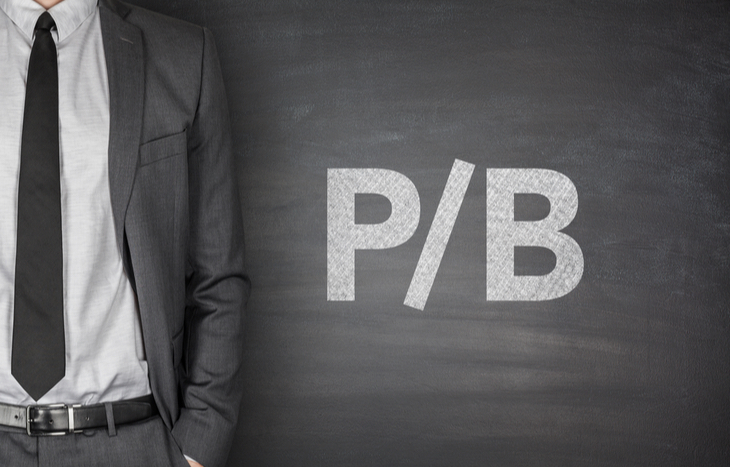What is Price-to-Book (P/B) Ratio?
Value investors are always looking for companies undervalued by the market. One of the favorite metrics of these thrifty investors is price-to-book (P/B) ratio. It’s the ratio between the price of a company’s share and its book value per share. Or, in simpler terms, a look at how much the market values the company above and beyond its intrinsic value. The lower the P/B, the closer to the intrinsic value of the company.
Like most price models and metrics, price-to-book measures the forward-looking sentiment of investors. In this case, the P/B signals how much growth potential investors see in the company. For example, if a company has a high P/B ratio, it suggests that investors believe it’ll grow larger than its current size in the near-term.
Price-to-book is an insightful metric for measuring market sentiment. With a clear gauge on the book value of a company, value investors can find great investment opportunities by looking at current share price.

How to Calculate Price-to-Book Ratio
Calculating price-to-book requires access to the company’s balance sheet. Or, at the very least, a summation of its total assets and liabilities. Once investors know the book value carried on the balance sheet, the equation is a simple one:
P/B Ratio = Current Price Per Share / Book Value Per Share
P/B ratio above one means the company currently trades for more than its intrinsic value. A ratio below one means the company trades at a discount. Don’t take the price-to-book ratio at face value, though: lower isn’t always better. Low P/B could signal an encumbered balance sheet and a negative P/B ratio might mean the company is insolvent.
What is a Good Price-to-Book Ratio?
A good P/B ratio depends on many factors. If you’re looking at an outright number:
- Anything between zero and one indicates an undervalued company.
- A P/B between one and four is typically considered ideal for value investors.
- P/B above 5 and climbing higher signals that investors might overvalue the company.
Keep in mind that these are ballparks. Factors like industry also play a role. A mining company may have a lot of assets on its balance sheet, which keep it trading at a lower P/B by nature of its book value. Likewise, investor eagerness over an up-and-coming tech company might send share prices soaring, which raises its P/B ratio. A “good” ratio depends on context.
What Does a Negative P/B Ratio Mean?
When a company’s P/B ratio shows up as a negative, it’s because there’s a negative book value (share price can’t go negative). This means the company is carrying more liabilities than assets on its balance sheet. The company is effectively insolvent, which means it’s probably not a good investment. Barring extenuating circumstances, investors should be wary of any companies posting a negative P/B ratio.
What Does a P/B Ratio Tell Investors?
This metric tells investors how much above a company’s intrinsic value its stock currently trades for. Most companies will trade with a high P/B ratio. This is because investors factor in sales performance, growth opportunities and more. It also has a lot to do with the company’s balance sheet and the tangible assets it holds.
For example, Facebook (NASDAQ: FB) trades with a P/B ratio of ~7.4 (September 2021). This means investors value the company roughly seven and a half times higher than the sum of its assets and liabilities on its balance sheet. This is likely because Facebook is a technology company with tremendous revenues and lots of intangible assets that enable its growth.
Now, take a company like AT&T (NYSE: T), which trades at a P/B ratio of ~1.2 (September 2021). As a telecom company, AT&T has a balance sheet that’s loaded with tangible assets—and plenty of liabilities. While it has strong revenue and profit, investors are mindful of the intrinsic value of the company.
Price-to-book ratio is really a value investing metric at its core. If a stock trades at or below its book value, there’s room to reap the benefits of share appreciation—provided the company measures up to other fundamentals.
Price-to-Book vs. Price-to-Tangible-Book Value Ratio
The biggest difference between these two metrics is that the latter (PTBV ratio) takes intangible assets out of the equation to focus solely on tangible assets. It’s calculated by subtracting the value of intangible assets from the company’s book value. Many investors prefer PTBV when evaluating a company because it gives a more accurate valuation—intangible assets like patents or intellectual property can be difficult to value.
PTBV ratio tends to be useful in resolving some of the sector-related discrepancies mentioned above. For example, evaluating an industrial or utility company using PTBV provides a clearer look at the premium (or discount) it’s currently trading for.
A Measure of Investor Sentiment
The higher the price-to-book (P/B) ratio of a company, the stronger the market’s sentiments toward it. Low P/B signals a potentially undervalued company, whereas negative P/B is cause for alarm—the company may be insolvent.
Understanding data analytics can go a long way for an investor to recognize stock trends. To learn more, sign up for the Profit Trends e-letter below.
While P/B is a useful tool, it’s best-used as part of a full range of analysis metrics. Price-to-book only tells a small part of the story. It’s best to contextualize investor sentiment with information about cash flow, earnings per share, return on invested capital and other analysis metrics. Sometimes, P/B is justifiably low if the outlook for a company is poor. Other times, low P/B could signal a diamond in the rough for value investors.





